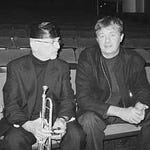Listen to "Winobranie" album now: https://ffm.to/kevxm0v Zbigniew Namysłowski (1939–2022) was a pioneering Polish jazz saxophonist, composer, and multi-instrumentalist who became one of Europe's most original jazz voices. Emerging in the 1960s, he gained international recognition as the first Polish jazz musician to record an album in the West (Lola, 1964). Known for his innovative fusion of jazz with Polish folk music, he developed a distinctive style marked by complex rhythms, adventurous harmonies, and instrumental experimentation – notably his electrified cello work. His 1973 masterpiece Winobranie epitomized his genre-defying approach, blending free jazz with Slavic folk motifs. Over six decades, Namysłowski recorded over 30 albums, mentored generations of musicians, and performed globally, cementing his legacy as a architect of Poland's jazz identity. The New York Times praised him as "one of jazz's great individualists," whose music "transcended political and geographical boundaries." Zbigniew Namysłowski's "Winobranie" (1973) stands as a revolutionary work in Polish jazz history, masterfully blending traditional folk influences with avant-garde experimentation. At a time when jazz behind the Iron Curtain operated under political constraints, Namysłowski crafted an album that smuggled radical innovation through its incorporation of Polish kujawiak melodies, Balkan rhythms in complex time signatures like 11/8, and Indian raga elements - all while maintaining the joyful energy of jazz improvisation. The album's groundbreaking use of electrified cello with wah-wah and fuzz effects created a psychedelic folk-jazz hybrid unlike anything else in contemporary jazz, while prepared piano and tabla expanded its sonic palette further. What made "Winobranie" truly remarkable was how it balanced this experimentation with disciplined composition, structuring free jazz elements within carefully crafted frameworks rather than embracing pure chaos. Recorded in 1973 as part of the state-approved "Polish Jazz" series, "Winobranie" became a subtle act of cultural resistance, using folk traditions as both musical foundation and coded commentary. Namysłowski himself admitted the quintet initially "faked" their way through free jazz until the album's pieces organically taught them how to navigate this challenging style. The result was a work that sounded simultaneously ancient and futuristic - rooted in Slavic musical heritage while pushing jazz into uncharted territories with its electric instrumentation and global influences. Over time, the album has earned recognition as one of Poland's greatest jazz achievements, standing alongside Krzysztof Komeda's "Astigmatic" in influence while maintaining its own distinct voice. Today, "Winobranie" remains a touchstone for musicians exploring the intersection of folk traditions and avant-garde jazz, its legacy enduring through its bold reimagining of what jazz could be. Tracks like "Gogoszary" with its frenetic 11/8 rhythms and "Taj Mahal" with its Indian-inspired textures continue to captivate listeners, proving that the most revolutionary art often emerges from creative constraints. The album represents not just a high point in Namysłowski's career but a defining moment in European jazz history - when Polish musicians demonstrated they could innovate on par with their Western counterparts while developing an entirely original musical language.
Playback speed
×
Share post
Share post at current time
Share from 0:00
0:00
/
0:00
Zbigniew Namysłowski Quintet – Winobranie (1973)
The Best Polish Jazz Albums
Apr 08, 2025
Polish Jazz Podcasts
The PolishJazz.com podcast celebrates legendary artists like Komeda and Stańko, exploring their legacies and key moments in Poland’s jazz history. From its roots to its role as a symbol of freedom, we examine how jazz reflected Poland’s struggles and triumphs. Through archives and stories, we bring this vibrant tradition to life. Join us to discover the magic of Polish jazz—a captivating blend of rhythm, history, and culture.
The PolishJazz.com podcast celebrates legendary artists like Komeda and Stańko, exploring their legacies and key moments in Poland’s jazz history. From its roots to its role as a symbol of freedom, we examine how jazz reflected Poland’s struggles and triumphs. Through archives and stories, we bring this vibrant tradition to life. Join us to discover the magic of Polish jazz—a captivating blend of rhythm, history, and culture. Listen on
Substack App
RSS Feed
Recent Episodes












Share this post